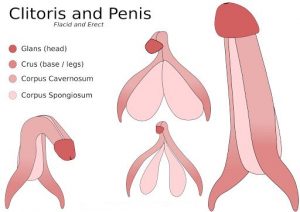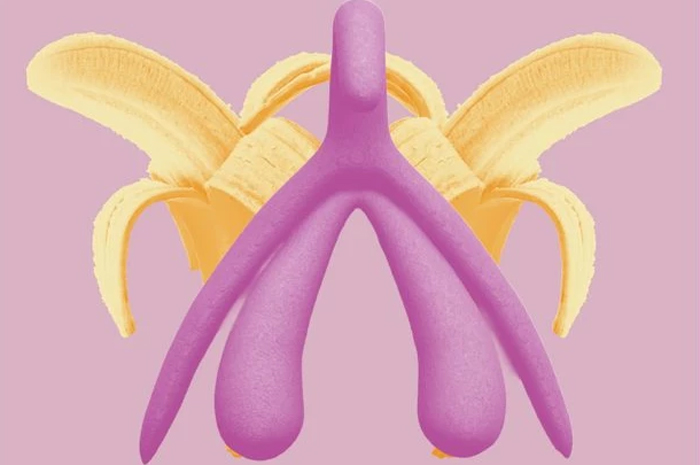Did you know that the penis and clitoris are virtually identical in almost every physiological way? Only recently has the clitoris been realized to be a much larger and more complex structure than the little pink pearl that most people are aware of. Ignorance about it is understandable when the vast majority of it is buried inside the female body, where the male genitalia are way more external. Knowledge about our genitalia could lead to us all having much better sex.
The clitoris and penis are about the same length – 3.5 to 5 inches
Though the external tip of the clitoris is small, the internal portion reaches deep into the body. It wraps around the vagina with crura (or, legs) and, overall, pretty well equals the size of a man’s penis. When the woman is fully aroused, the internal part of the clitoris engorges with blood and becomes highly sensitive – which is why penetrative intercourse can feel so sensually great.
This explains why stroking the area called the ‘G-Spot’ on the front wall of the vagina feels so good to be stroked – when in fact you are stimulating the underside of the clitoris. As with men, you can also stimulate it via the urethra and the anus, giving the possibility of orgasms from multiple angles and forms of sex.
Sadly, many women are not educated enough about their bodies (nor confident enough in their sexuality) to explore these types of internal orgasms. Instead, they focus solely on pleasure from their external clitoris through masturbation or oral sex. Not to say that external clitoral orgasms aren’t fantastic – there’s just so much more to explore!
Both the clitoris and penis have a hood and a shaft
Just as with the foreskin protecting the head or glans of the penis (sometimes removed by circumcision), the external portion of the clitoris has a hood that protects the most sensitive part. A difference is that head of the penis has around 4,000 nerve endings, where that little female pearl tip has more than 8,000.
The clitoris can be stimulated better if the skin just above the pubic bone is manually pulled to expose the shaft for stimulation (like the way an uncircumcised man pulls back his foreskin to expose the more sensitive portion of the head and shaft of the penis).
When the upper vulvic area is stimulated, women will experience external clitoral and labial engorgement, including swelling and a deepening of the colour of the tissue. Actually, though, most of the engorgement takes place inside, along the two legs (crura) and bulbs (vestibule – equivalent to those in the penile shaft) that wrap around the vagina. This is what makes stimulation from more places than just the external clitoris feel incredibly pleasurable.

Both clitorises and penises engorge with blood to becomes erect
Sexual stimulation of the clitoris causes it to begin to engorge, or fill with blood. Arousal actually usually begins in the mind as we get excited about the possibility of sex, or when thinking of a particular fantasy.
Clitoral engorgement also increases with arousal via the mouth, nipples, labia, thighs, anus and anywhere else that is an erogenous zone. Even where an orgasm isn’t achieved, sexual stimulation releases oxytocin and other hormones that contribute to a deep sense of well-being and relaxation and leads to better overall health. For both men and women, testosterone is the hormone that is a significant driver of sexual desire – and vasopressin helps to make the penis and clitoris more erect.
Not only does the clitoris become erect like a penis, but it also produces lubrication to seep into the vagina allow for easier penetration. It can also ejaculate, like a penis. Most of the ejaculate in the man comes from the prostate glands, for women it is the Skene’s glands found on the front wall of the vagina. These fluids may range from hardly a dribble to a squirting gush.
The climax of sexual excitement is orgasm involving contractions of the pelvic muscles around 0.8 seconds apart. However, the female orgasm, though reached less often than the male, typically lasts longer than the male at an average of around 13 to 51 seconds. Another difference is that, unlike men, most women do not have a refractory (recovery) period and so are much more capable of further/multiple orgasms.
The genitals start the same in the womb
It’s important to understand that the genitals a person is born with do not determine their gender. Having a clitoris does not automatically make a person a woman, nor does having a penis mean you must be a man. Genitals determine a person’s biological sex, where gender is the expression of the orientation a person, which can range across a broad spectrum – though this has sadly only recently become widely recognized. These two things, while often related, are not one and the same.
What’s more, not every single person has male or female genitals. Some people are born with some combination of both male and female genitals, which is known as intersex.
In the first six weeks of the foetus’ development, the genes on the sex chromosome kick in and the fetus becomes cis-male, cis-female, or, in some instances, intersex. These sexual differences are expressed as the penis and testes (cis-male), the vulva and vagina (cis-female), or some combination of the two structures (intersex).
However, before the sex chromosomes are expressed, all foetuses actually begin as cis-female, meaning that everyone begins their development in the womb with a clitoris. Then, one of two things happens: either a low level of the hormone testosterone is released and this structure grows into a penis, or, when testosterone is absent, the tissues develop into a vulva – including the clitoris and vagina. Indeed, the reason men have what looks like a seam on the reverse side of their penis and across the scrotum, is the fusing of what would have been the lips of the vulva.
The truth is that all embryos start with a small tissue nub of nerves that is the same – where the clitoris is the template and it is the penis that is the mutation. The penis then grows outside the body while the clitoris mostly remains within.
The penis also has crura or “legs” which are just inside the body, below the bulb which are formed from the clitoral legs which sit alongside the vestibular bulbs, extending down long the vaginal opening, inside of the body.
Here’s a list of the equivalences:
- Glans clitoris = head of the penis
- Clitoral hood = foreskin
- Outer lips (outer labia) = scrotum
- Inner lips (inner labia) = skin of the penis
- Shaft of the clitoris = shaft of the penis
- Clitoral bulbs (part of internal clitoris, vestibular bulbs) = bulb of penis
- Clitoral legs (part of internal clitoris, crura) = crura of penis
Some ways the clitoris differs from the penis
First off, we’ve noted that the clitoris has twice as many nerve endings as the penis. It is also the only organ wholly dedicated to sexual pleasure – where the penis has to multitask also as a urine expressing organ. Then again, it has to work with the vagina for penetrative sex and fertilization, not just the clitoris.
Also different from the penis – and all men would surely wish for this — the clitoris actually grows as women age. By the age of 32, it is almost four times the size it was at puberty, meaning there is more surface area to stimulate with sexual activity. And it is only by the time of menopause, the clitoris has reached its full size. Typically, the penis stops growing by the time the male reaches the age of 18.
Male and female sexual pleasure
While every human is different and enjoys different kinds of stimulation, the commonly held idea that males find it easier to reach orgasm than females is a myth born out of a lack of proper understanding of anatomy. The clitoris, with, as noted, twice as many nerve endings is, if anything, actually more capable of providing sexual pleasure than the penis.
Most everyone enjoys sex regardless of the genitals they possess. All sets of genitals require arousal for sensation and most genitals appreciate being touched in a variety of ways from soft to rough, with consistent rhythmic stimulation. So, if people were given better education about sex, pleasure, and the human body — including how surprisingly awesome all our anatomy is — we’d probably all be having way better sex.

